RELUCTANTLY RE-READING THE LAND
| April 22, 2011 | Post In LEAP 8
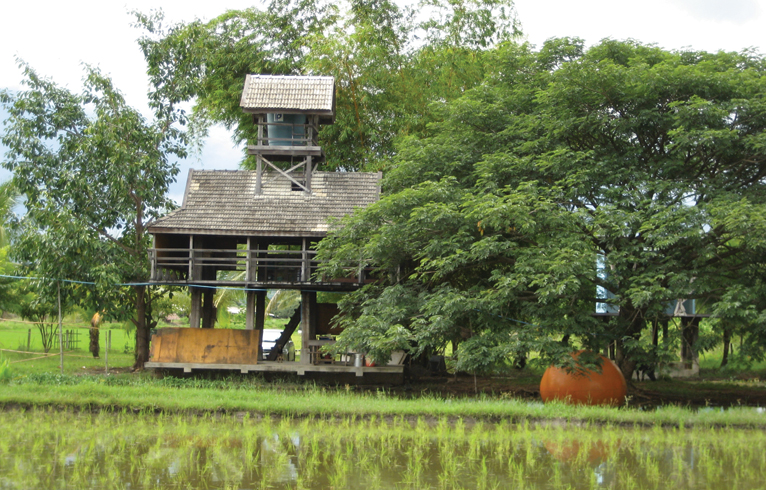
Creation myths are all more or less the same, but this one is better than most. In 1998, Rirkrit Tiravanija and Kamin Lertchaiprasert buy a piece of land in Sanpatong, a village twenty minutes by car outside Chiang Mai. It has no water or electricity. They intend to use it to bypass the concept of ownership, to create a community. They want it to be off the grid, a model for a different kind of living. It is. Then the artists start coming. First the local Thais, then Rirkrit’s friends, Tobias Rehberger, Superflex, Philippe Parreno, and the like. And then the curators. Within five years, it has become a “station,” a nice word, a Rirkritian word, for a place where people are on the way to somewhere else, but possibly up for a good conversation while they wait. Everyone visits, and these few acres so close to but far from Thailand’s second city, which nonetheless feels like a mountain hideout, becomes a sort of signal for a certain kind of cosmopolitanism among an already extremely cosmopolitan set. Its being “off the grid” makes putting it onto one’s grid all the more essential. “It was quite far away,” Rirkrit says, “from a lot of things.”
The Land, it’s called in English. In Thai, Rirkrit usually has to explain, it is better rendered “the rice field.” The slippage is important, as these are different valences. One is abstracted, a place named by the most basic possible name for a place, a name that could apply to any place, used by people who spend their time among many places. The other is specific to the point of generality, the singular realm of the one confined there, the object of burden, the source of nourishment, the world of a single peasant, the world of a water buffalo. A living archetype.
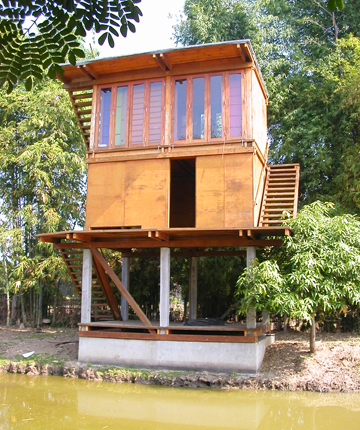
The idea is simple, the kind of simple whereby things generally assumed or understood are given voice to, named, talked about. A basic condition ensues in which everything is the possible subject of inquiry, the topic of an urgent conversation. In worlds like this, the most routine object assumes metaphorical significance, anything can mean something. It’s a strategy that we see here and there these days, a sort of detournement of the obvious, like the mezzanine in the new Vitamin Creative Space outpost in a Beijing condominium complex, a platform (literal and figurative) sitting at the top of a miniature staircase that is theorized as an interstice, a grandstand, and a bookshelf. Sure there are other discourses at play on The Land— a strand of communitarian utopianism, another of environmental sustainability, a third of new-age farming precepts that dictate the parcel’s composition must mimic that of the human body, three fourths liquid. But the unrelenting commitment is to asking deceptively simple questions, and making unapologetically basic points, about the practice of everyday life.
Beside the pond, Rirkrit builds The Land’s first house, structured according to the “three spheres of human need.” The bottom is open to the elements because the floods will come, and centers on a stove, a place for exchange, conversation, dialogue, dialectic. The middle is a space for meditation or reading, things of the mind, a room of one’s own, floating above the fields. The top is a bamboo black box merely for sleep, bodily necessity given architectural form. More buildings follow. Rehberger, who would go on to build the prizewinning Venice Biennale caffeteria in 2009 (a project later licensed by the Italian coffee brand Illy and reinstated at art festivals elsewhere), builds a simple house based on his favorite spaetzle. (How exactly that relationship works, Rirkrit denies ever having known.) Originally assembled in and shipped from Sweden, it is localized as its materials rot and need replacing. Further projects look to fulfill more advanced needs, like electricity, to expand the scope of the community as created. Parreno and Francois Roche get ambitious, making a “Battery House” of plastic palm fronds. Produced as a set for Parreno’s film “The Boy From Mars,” it aims to offer a place for larger assembly and display. The Danish collective Superflex design a system for turning buffalo manure into cooking gas for a communal kitchen, and a set of bright orange containers that float on the pond, holding the fuel-to-be. Eventually, structures ring the rice fields.
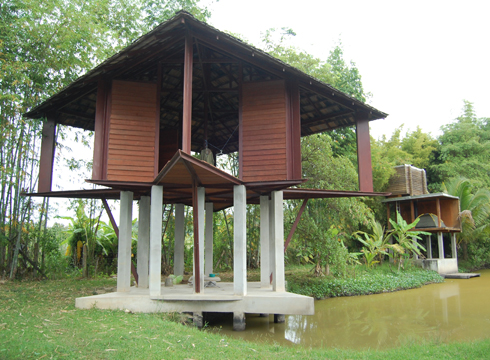
One imagines a few fun periods having happened there, when one or another of these outsiders came to install their project, and a world was instantly and briefly conjured around the guest. Conversations stretching deep into dark subtropical nights, possibilities hatched and perhaps acted upon. For those of us a half-generation younger than the artists who were part of that initial formation, there is now a feeling of having come to the gathering slightly late. Theirs was a moment, more or less bookended by the exhibitions “Cities on the Move” (1996 ff.) and “Utopia Station” (2003), that marks our earliest inklings of what the art world, and particularly the art world beyond its erstwhile centers, might look like. At that moment, of course, this was what things looked like, not just here, but in a larger conversation wherein “relational” strategies were ascendant, championed, or posited as having been championed, by many of the people active here. This is no sculpture garden; The Land fends off those who would merely “put things there.”
The story of the land is in key ways less the story of Rirkrit than of Kamin. Today they live in abutting homes back in Chiang Mai proper, although Kamin is in his much more of the time, enough to run a Sunday meditation group in his studio that is a sort of regular fixture for young artists and seekers there. Rirkrit wandered the world while Kamin tended the hearth, dealt with the locals, took the random visitors around, helped them to order food, all of course while maintaining a prolific practice as a sculptor and a painter. In 2005 The Land becomes The Land Foundation, in what Rirkrit calls “one of our ways to take the property out of being a property.” A makeshift foundation without steady funding, it nonetheless maintains a small office and organizes a one-year residency project aimed at “young artists, or people between school, to stay on the land and basically try and survive off the land.” They cultivate rice year-round, eating some themselves, donating some to the nearby villagers. In the subtlest of ways, it becomes a thing one might do in the global constellation of art-world options, its locality and immediacy modulated and amplified by its shadowy, even unintentional, presence online. A website, all grass motifs and 404 errors shows lo-fi panorama shots of the community around the pond.
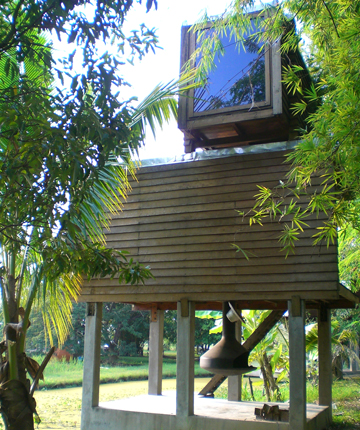
WE ARRIVE IN the back of Kamin’s pickup truck one December afternoon with a couple of state-funded Norwegians and our typical Chinese cohort of art journalists, guests of the Tang Gallery, which has flown us here for an intervention by a Chinese artist named Lin Yilin [see LEAP 7]. We know we’re a decade and change late, but we don’t necessarily care; after all the panels we’ve heard and interviews we’ve read about this place, we have to at least see it for ourselves. There haven’t been so many new buildings in the last few years, and the ones that are here have fell apart a bit since Daniel Birnbaum visited on assignment for Artforum in 2005. The buffalo, Kamin tells us, have been given to a magical sounding “buffalo foundation.” A beautiful, incipient decay reigns.
Lin Yilin made his name as a member of the Big Tail Elephant, a short-lived but maybe still existing performance collective in the Guangzhou of the early 1990s. In 1993, just a few months after Rirkrit first served Thai curry to bemused New Yorkers out of the 303 Gallery, Lin transported a cinderblock wall across a street in Guangzhou, brick by arduous brick. He has always had a thing for walls, using them in his installations more or less continuously since then, fascinated by their structural simplicity, their symbolic ambiguity, their interrogative power. Here, on the edge of The Land, he has built another wall, plastered in gray. From a hole protrudes a balance, from the balance hangs a basket, in the basket we are asked to sit, have our weights recorded, write them on the wall in chalk. The wall divides, or rather draws attention to a perceived division between, the reflexivity of The Land proper and the matter-of-factness of the surrounding “regular,” “real” rice fields. The balance faces outward, to be used by any farmer passing by. Generosity, is after all, a key concept here.
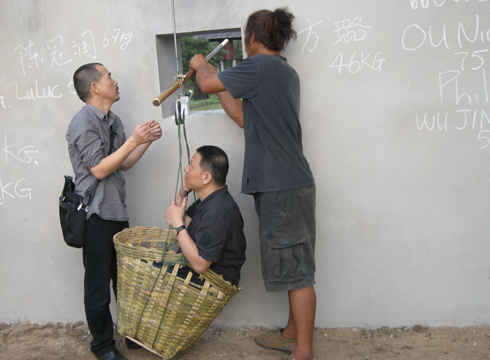
The other key concept is labor, the idea that one can learn from the farmers, the all-too-familiar modality of young intellectuals in the fields, the echoes too loud to ignore. Really at stake here is nothing smaller, and nothing bigger, than the difference between a mobile intelligentsia and an agricultural proletariat, tradition and modernity, impact and response. The great cliched discourses of development, muted into subtext, present only substructurally.
Back at the wall, people weigh themselves with Lin Yilin and Kamin’s help. Some also weigh their dogs. Some, having weighed themselves, go to sit atop the wall, waiting for the day to end. Ambient music is piped in from a car parked on the access road. It all has the feel of a staged encounter, with no one quite sure where anyone else is coming from. Rirkrit’s wife, photographer Antoinette Aurel, shows up in a Liam Gillick t-shirt that reads, in Helvetica caps, “WHO THE FUCK IS REM?”
Curry is served. Conversations begin. We grab our bowls and take them down to the pondside, to a platform with a bench looking out over the fields that is actually a work by Lasse Ernlund Lorentzen, titled The Maintenance of European Culture, from 2005. The tension that Birnbaum cited in that same year, between “the extension of today’s art world to places far from the centers of commerce” and “Tiravanija’s ambition to break out of the traditional art circuit” doesn’t seem so acute. The whole place, in fact, doesn’t seem so far away. The sun sets over the rice field.

